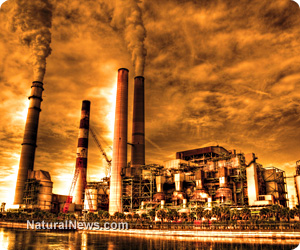
While EPA shuts down coal plants in the USA, China unveils monstrous greenhouse gas polluters called an 'environmental disaster'
Tuesday, October 01, 2013 by: J. D. Heyes
Tags: China, greenhouse gas polluters, environmental disaster
- Newly released JFK files reveal Pentagon's role in creating Lyme disease and covid in the same lab
- Kiss Your Genetic Privacy Good-Bye! 23andMe Gets Green Light to Sell Your Intimate Genetic Details to Anyone They Want
- Sugar-free deception: Artificial sweeteners hijack hunger signals, fuel obesity epidemic, study warns
- Woman contracts WORLD'S DEADLIEST VIRUS after unknowingly being given the WRONG VACCINE
- Sweden's migrant crisis deepens as failed green energy venture leaves thousands jobless, exposes systemic collapse
- A handful of pecans a day could keep heart disease at bay, study finds
- Is the vaccine-autism debate reopening? Washington Post sparks controversy with preemptive hit piece on David Geier
- Advisory: Ex-FBI agent exposes likely ATF honeypot operation selling illegal Glock switches
- Pediatric dentist exposes fluoride dangers as more states ban toxic water additive
- RFK Jr. slashes HHS bureaucracy, saves taxpayers $1.8B while refocusing on chronic disease epidemic
- Challenging the status quo: “America Fooled” by Timothy Scott exposes the myths about antidepressants
- The case for locking up the Deep State's biggest hatchet man...
- Could camel milk be a game-changer for autism? Science says it’s worth exploring
- Revolutionize your diet with pomegranate: The miracle juice for gut health and metabolism
- AI weather model outperforms traditional forecasts, boosts accuracy by 20%
- North Carolina Supreme Court rules family can sue over COVID-19 force-vaccination of teen without parental consent
- Cauliflower: From ancient crop to modern superfood
- Israel’s Gaza offensive claims over 100 Palestinian lives daily, rights monitor reports
- Newly released JFK files reveal Pentagon's role in creating Lyme disease and covid in the same lab
- Analysis: The coming economic collapse, a mass uprising and Trump's three secret weapons to halt the growing revolt
- Trump nominates VACCINE ZEALOT Susan Monarez to lead the CDC, sidelining RFK Jr.'s reform efforts
- Trump's greatest betrayal so far: Accelerating Middle East wars, silencing dissent, and serving Zionist masters
- CDC finally halts $11 billion COVID funding scam as health officials admit the ‘pandemic’ was a fraud
- The hidden dangers in your kitchen: How cooking methods impact diabetes, cancer and aging
- BEWARE: USDA allows genetically engineered vaccines to infiltrate organic food production
- Obama accused of laundering USAID funds to fuel global protest movements, regime change operations
- DEADLY DECEPTION: How COVID vaccines increased mortality rates and why authorities hid the truth
- Here are TEN all-natural ways to protect your garden without using harmful chemicals
- Dr. Mike Yeadon releases 15-minute testimony - WATCH - about genocidal intent of COVID “vaccines”
- Festive flavors: The sweet history, nutritional profile and health benefits of pecan pie
- Big Pharma's media takeover: How drug companies bought the news - and your health
- Dr. Suzanne Humphries makes bombshell appearance on Joe Rogan podcast, exposing vaccine industry deception back to POLIOMYELITIS
- Elon Musk: Aliens could be here on Earth RIGHT NOW
- 5 Simple steps to boost your brainpower: How to strengthen executive function in a distracted world
- Trump reverses course on Gaza plan, says “nobody is expelling Palestinians”
- California's social media censorship law struck down: A victory for free speech or a threat to online safety?
- Newly released JFK files reveal Pentagon's role in creating Lyme disease and covid in the same lab
- EPA advisor admits the agency is funneling billions to climate groups ahead of Trump’s return to White House
- California's social media censorship law struck down: A victory for free speech or a threat to online safety?
- Dr. Mike Yeadon releases 15-minute testimony - WATCH - about genocidal intent of COVID “vaccines”
- The Health Ranger releases “Vaccine Zombie” song and music video, using AI-animated zombies for the music video
- Florida takes a stand: DeSantis proposes permanent ban on mRNA vaccine mandates
- The pandemic as a tool for INDOCTRINATION: Understanding “The Indoctrinated Brain” by Dr. Michael Nehls
- “Why we influenced the 2020 elections”: Facebook files reveal the coordinated effort to bury the Hunter Biden laptop story
- Mike Adams releases country western hit single: Goin’ Back in Time is Comin’ Home
- Mike Adams releases music poetry sensation: A Child of God
- Unpacking the Lies That We’ve Been Fed – new song and music video released by Mike Adams, the Health Ranger
- Michigan sheriff announces criminal investigation into 2020 election crimes, Dominion Voting Systems
- Migrants are taking advantage of recent hurricanes to scam residents and loot their homes
- House Intelligence Committee calls for the ARREST and PROSECUTION of Dr. Anthony Fauci
- Rep. Nancy Mace introduces bill to ban biological males from female facilities on federal property
- Peter Rost exposes Big Pharma corruption in his book “The Whistleblower: Confessions of a Healthcare Hitman”
- Former horse rancher and 6,000 other plaintiffs are suing Syngenta after paraquat exposure led to Parkinson's Disease
- Mike Adams releases new song and music video: Nothing More Disgusting Than a Globalist
- Red Cross issues warning to stop blood plasma donations from vaccinated people
- Scientists confirm: GENIUS brain function can be spontaneously unleashed in humans without any apparent cause
- EPA advisor admits the agency is funneling billions to climate groups ahead of Trump’s return to White House
- HYSSOP: What research reveals about the health benefits of this ancient holy herb
- Two containers with completed ballots fall out of truck in Florida
- Fully vaccinated about to see “tsunami” of illness and death, warns virologist
- Global leaders unite to clamp down on “misinformation” with UN-backed Cascais Declaration
- BREAKING: 2025 NDAA authorizes mandatory military draft of WOMEN across America… as Pentagon pursues global NUCLEAR war with both Russia and China at the same time
- Michael Yon warns of a ZIONIST TAKEOVER in Trump’s second administration
- BOMBSHELL: DNA testing kits are a SCAM to develop ethnic-specific bioweapons
- Ozempic and Wegovy weight loss drugs are injectable LIZARD VENOM PEPTIDES that may unleash a devastating wave of organ failure… side effects align with symptoms of SNAKE BITES
- Israeli soldiers accused of even more torture and abuse in the West Bank
- These 13 countries just signed an agreement to engineer a global FAMINE by destroying food supply
- NASA admits that climate change occurs because of changes in Earth’s solar orbit, and NOT because of SUVs and fossil fuels
- RFK Jr. clears key hurdle: Sen. Susan Collins backs controversial HHS nominee, signaling a new era for health policy
- Sermon 30: How Jesus reveals Caesar’s FAKE CURRENCY and FALSE AUTHORITY
- Coriander seeds: Ancient medicine backed by modern science
- Arizona officials claim Maricopa County needs 10-13 days to tabulate results of the election
In fact, in terms of energy production, the Obama administration's EPA is working overtime to shutter U.S. coal-fired plants, though of course, the agency doesn't have any realistic recommendations for replacing those lost plants.
The world's biggest polluter - China - is preparing to get even bigger. As U.S. plants are in danger of being shut down, China's about to build behemoth plants that will triple the pollution.
Per Science Daily:
Coal-powered synthetic natural gas plants being planned in China would produce seven times more greenhouse gas emissions than conventional natural gas plants, and use up to 100 times the water as shale gas production, according to a new study by Duke University researchers.
Tons more toxins in the atmosphere
In a bid to meet its growing domestic and export industrial needs, China has largely ignored the environmental costs it is inflicting on its territory and people, which could put the country on an irreversible and unsustainable path for decades.
"Using coal to make natural gas may be good for China's energy security, but it's an environmental disaster in the making," said Robert B. Jackson, Nicholas Professor of Environmental Sciences and director of the Duke Center on Global Change.
"At a minimum, Chinese policymakers should delay implementing their synthetic natural gas plan to avoid a potentially costly and environmentally damaging outcome," added Chi-Jen Yang, a research scientist at the center. "An even better decision would be to cancel the program entirely."
Yang is lead author of the new study, published recently in the peer-reviewed journal Nature Climate Change.
As part of the largest-ever investment in coal-fueled synthetic natural gas plants in history, the central government in China has adopted construction plans for nine of the behemoth plants, which are said to be capable of producing more than 37 billion cubic meters of synthetic natural gas every year.
Private companies plan to build an additional 30 plants, which will be capable of producing as much as 200 million cubic meters of natural gas per year - which far exceeds the country's current demands.
"These plants are coming online at a rapid pace. If all nine plants planned by the Chinese government were built, they would emit 21 billion tons of carbon dioxide over a typical 40-year lifetime, seven times the greenhouse gas that would be emitted by traditional natural gas plants," said Jackson.
"If all 40 of the facilities are built, their carbon dioxide emissions would be an astonishing 110 billion tons," he added.
The study by the Duke researchers found that if gas produced by the new plants was used to generate electricity, the total lifecycle greenhouse gas emissions would be somewhere between 36 and 82 percent higher than pulverized coal-fired power.
Moreover, if the synthetic natural gas produced by the plants were applied to fuel vehicles, the lifecycle emissions would be twice as high as gas-powered vehicles.
Extreme water use also a problem
"The increased carbon dioxide emissions from the nine government-approved plants alone will more than cancel out all of the reductions in greenhouse gas emissions from China's recent investments in wind and solar electricity," Yang said. "While we applaud China's rapid development in clean energy, we must be cautious about this simultaneous high-carbon leapfrogging."
The researchers said the plants would also spew hydrogen sulfide and mercury, which, if not scrubbed and treated properly, are potentially harmful to humans.
They said they were also concerned about excessive water consumption at the plants.
"Producing synthetic natural gas requires 50 to 100 times the amount of water you need to produce shale gas," Yang said. "The nine plants approved by the government -- most of which are located in desert or semi-desert regions in Xinjiang and Inner Mongolia -- will consume more than 200 million tons of water annually and could worsen water shortages in areas that already are under significant water stress."
Sources:
http://www.sciencedaily.com
http://www.rdmag.com
http://spectrum.ieee.org
China at FETCH.news
Get independent news alerts on natural cures, food lab tests, cannabis medicine, science, robotics, drones, privacy and more.
Take Action: Support Natural News by linking to this article from your website
Permalink to this article:
Embed article link: (copy HTML code below):
Reprinting this article:
Non-commercial use OK, cite NaturalNews.com with clickable link.
Follow Natural News on Facebook, Twitter, Google Plus, and Pinterest
Science News & Studies
Medicine News and Information
Food News & Studies
Health News & Studies
Herbs News & Information
Pollution News & Studies
Cancer News & Studies
Climate News & Studies
Survival News & Information
Gear News & Information
News covering technology, stocks, hackers, and more



"Big Tech and mainstream media are constantly trying to silence the independent voices that dare to bring you the truth about toxic food ingredients, dangerous medications and the failed, fraudulent science of the profit-driven medical establishment.
Email is one of the best ways to make sure you stay informed, without the censorship of the tech giants (Google, Apple, Facebook, Twitter, YouTube, etc.). Stay informed and you'll even likely learn information that may help save your own life."
–The Health Ranger, Mike Adams













































